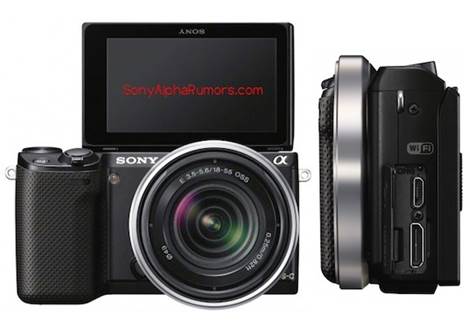The quality of electronic viewfinders
continues to get better, and the 2.4million-dot OLED display here impresses for
a number of reasons.
It's larger than expected, yet not so large
that the entirety of its feed cannot be comfortably taken from one position
(which includes all exposure information around it). It’s bright and contrasty,
and presents details with unprecedented clarity only when looking through it
for extended periods do you notice a touch of noise and artefacts dancing
around details.

SONY
NEX-6 Camera
One issue which does occasionally rear its
head is the sensitivity of the viewfinder sensor, which deactivates the rear
display when a hand or finger passes its area of sensitivity. This is not
normally too great an issue with many cameras, although the LCD screen’s
tiltable nature means hands are more likely to get in the way.
Testing showed the camera to maintain its
10fps burst mode for up to nine Raw + JPEG frames when it’s used in conjunction
with a formatted UHS-1 SDHC card, with these images flushed away in 10 to 12
seconds. This is impressive, and it’s welcome to see that the camera returns to
being operational during the latter seconds of writing.
The camera also does very well with
shot-to-shot times, quickly processing and writing images to the memory card to
ensure no slowdown when shooting subsequent images, making it ideal for
situations where you may need to capture a number of images in quick
succession, not necessarily in a continuous burst.
With the 16-50mm kit lens, the camera’s
focusing system bounces back and forth a little each time it’s asked to focus,
which makes it a touch slower than those on competing models, but it’s still
brisk enough for most types of shooting. Pleasingly there appears to be no
shutter lag, with images captured immediately.
Image quality
Tone and exposure
The camera's metering system is as reliable
as expected, with only scenes containing many brighter areas requiring manual
intervention to lift up shadow details. The DRO feature has a noticeable effect
on such images - the branches of a tree against a sky for example.

The
camera's metering system is as reliable as expected, with only scenes
containing many brighter areas requiring manual intervention to lift up shadow
details.
White balance and color
The AWB system behaves well in natural
light, although performance is mixed when capturing under artificial sources,
with images not always retaining the true character of the lighting source.
Sharpness and detail
The kit lens needs to be stopped down for
it to achieve maximum sharpness, as results at wider apertures are soft. Once
stopped down, and when correct technique is applied, details are plentiful.
ISO quality
Chroma noise appears in images as low as
around ISO 400, although this tends to be confined to areas of little detail.
Shooting at higher sensitivities at nighttime, the camera effectively processes
out noise from shadow areas, and images still retain a fine integrity in terms
of their color and white balance.
Kit lens performance
At wider focal lengths the NEX-6 struggles
to maintain sharpness in its corners, with a kind of stretching known as volume
anamorphosis visible. This is the case with a number of lenses. Distortion at
the 16mm end of the 16-50mm Power Zoom kit lens is pronounced, but the
in-camera processing manages to rectify this to a reasonable degree, leaving
just a slight unevenness when capturing linear subjects. Some chromatic
aberration is also visible in both Raw and JPEGs.

At
wider focal lengths the NEX-6 struggles to maintain sharpness in its corners,
with a kind of stretching known as volume anamorphosis visible.
Verdict
The NEX-6 fills an admittedly small gap
between the NEX-5R and the NEX-7, with the large and bright viewfinder giving
it a significant advantage over its viewfinder-less rivals. At around $200 less
than the NEX-7, but with a similar feature set, it’s also good value for money
if you envisage using the viewfinder and/or the flip-out LCD -otherwise, there
are slightly cheaper comparable options. Its only significant issue with
handling concerns the small space between the generously-proportioned grip and
the lens mount. Image quality can be excellent at times, although minor Auto
White Balance inconsistencies, poor corner sharpness with a number of lenses
and occasionally lackluster performance with the 16-50mm power zoom lens all
make themselves known. Still, with prompt write and shot-to-shot times, as well
as a competent AF system, it’s an excellent choice for situations in which
rapid response is required.
|
Specifications
§ Sensor:
16.1MP APS-C type
§ Output
size: 4912 x 3264
§ File
formats: Raw. JPEG. Raw + JPEG
§ Compression:
Fine. Standard
§ Color
space: sRGB. Adobe RGB
§ Shutter
speeds: 30-1/4000sec. BULB
§ Image
stabilization: No (available through OSS lenses)
§ ISO:
100-25.600
§ Exposure
modes: Auto, Superior Auto. P. A. S. M. Scene
§ Metering
system: 1200-zone evaluative, center-weighted.sdot
§ Drive
mode : 10fps
§ Movie
mode: 1920 x 1080 (50d. 50i. 24d1
§ Display:
3IN TFT LCD, 922k dots
§ Viewfinder:
OLED type, 2.4m dots
§ Field
of view: 100%
§ Focusing
modes: Single, continuous, manual
§ Memory
card: SD, SDHC, SDXC, MS
§ Connectivity:
USB 2.0, HDMI MINI
§ Weight:
287a (without lens)
§ Dimensions:
119.9 x 66.9 x 42.6mm
Pros
§ Operational
speed
§ Fast
write times
§ Large,
bright viewfinder
§ Tiltable
LCD
§ Large
grip
Cons
§ Recessed
buttons
§ Inconsistent
AWB under artificial light
§ Lack
of space between lens and grip
|